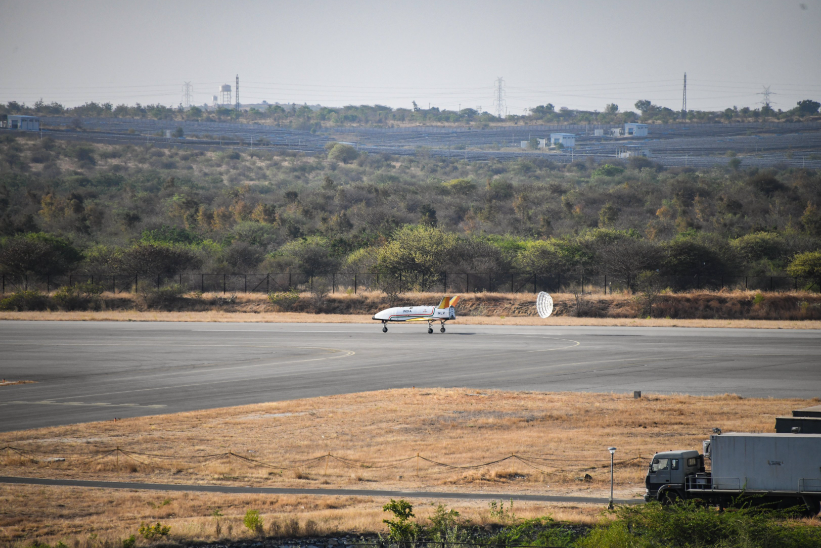
ISRO successfully achieves autonomous landing of 'reusable launch vehicle'

The Indian Space Research Organisation (ISRO) on Sunday (April 2) successfully conducted the Reusable Launch Vehicle Autonomous Landing Mission (RLV LEX) at the Aeronautical Test Range (ATR) in Karnataka’s Chitradurga.
“With that, ISRO successfully achieved the autonomous landing of a space vehicle,” it said in a statement.
Also read: ISRO’s LVM3 successfully deploys 36 satellites into designated orbits
“With LEX, the dream of an Indian Reusable Launch Vehicle arrives one step closer to reality,” ISRO said.
In a first in the world, a winged body has been carried to an altitude of 4.5 km by a helicopter and released for carrying out an autonomous landing on a runway.
ISRO, DRDO, IAF Jointly Conducted RLV Test@isro @DRDO_India and @IAF_MCC conducted the Reusable Launch Vehicle Autonomous Landing Mission (RLV LEX) successfully from Aeronautical Test Range, Chitradurga, Karnataka this morning.
Date : April 2, 2023 pic.twitter.com/HWfMHqIvLJ
— Indian Aerospace Defence News (IADN) (@NewsIADN) April 2, 2023
RLV is essentially a space plane with a low lift to drag ratio requiring an approach at high glide angles that necessitated a landing at high velocities of 350 kmph.
The craft took off at 7:10 am IST by a Chinook Helicopter of the Indian Air Force (IAF) as an underslung load and flew to a height of 4.5 km (above Mean Sea Level). Once the predetermined pillbox parameters were attained, based on the RLV’s Mission Management Computer command, the RLV was released in mid-air, at a down range of 4.6 km.
Release conditions included 10 parameters covering position, velocity, altitude and body rates, etc. The release of RLV was autonomous. The RLV then performed approach and landing manoeuvers using the Integrated Navigation, Guidance and control system and completed an autonomous landing on the ATR air strip at 7:40 AM IST. The autonomous landing was carried out under the exact conditions of a Space Re-entry vehicle’s landing high speed – unmanned, precise landing from the same return path as if the vehicle arrives from space.
Landing parameters such as ground relative velocity, the sink rate of landing gears, and precise body rates, as might be experienced by an orbital re-entry space vehicle in its return path, were achieved.
The RLV LEX demanded several state-of-the-art technologies including accurate navigation hardware and software, pseudolite system, Ka-band radar altimeter, NavIC receiver, indigenous landing gear, aerofoil honey-comb fins and brake parachute system.
LEX utilised several indigenous systems. Localized navigation systems based on pseudolite systems, instrumentation, and sensor systems, etc. were developed by ISRO. Digital Elevation Model (DEM) of the landing site with a Ka-band Radar Altimeter provided accurate altitude information. Extensive wind tunnel tests and CFD simulations enabled aerodynamic characterisation of RLV prior to the flight.
Also read: ISRO successfully carries out controlled re-entry of aged satellite MT-1
“Adaptation of contemporary technologies developed for RLV LEX turns other operational launch vehicles of ISRO more cost-effective”, the statement said.
ISRO had demonstrated the re-entry of its winged vehicle RLV-TD in the HEX mission in May 2016. The re-entry of a hypersonic sub-orbital vehicle marked a major accomplishment in developing Reusable Launch Vehicles. In HEX, the vehicle landed on a hypothetical runway over the Bay of Bengal. Precise landing on a runway was an aspect not included in the HEX mission.
The LEX mission achieved the final approach phase that coincided with the re-entry return flight path exhibiting an autonomous, high speed (350 kmph) landing. The LEX began with an Integrated Navigation test in 2019 and followed multiple Engineering Model Trials and Captive Phase tests in subsequent years.
Along with ISRO, IAF, Centre for Military Airworthiness and Certification (CEMILAC), Aeronautical Development Establishment (ADE), and Aerial Delivery Research and Development Establishment (ADRDE) contributed to this test. The IAF team hand in hand with the Project team and multiple sorties were conducted to perfect the achievement of release conditions. Secretary in the Department of Space and ISRO Chairman S Somanath was among who witnessed the test.

